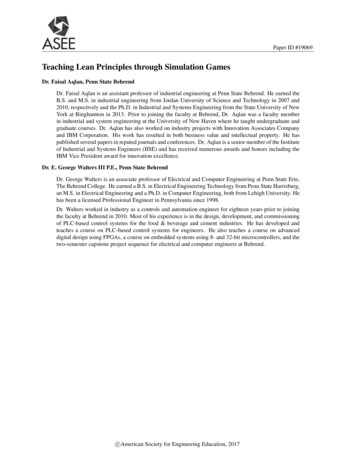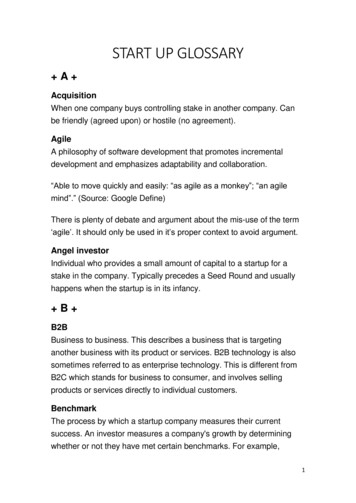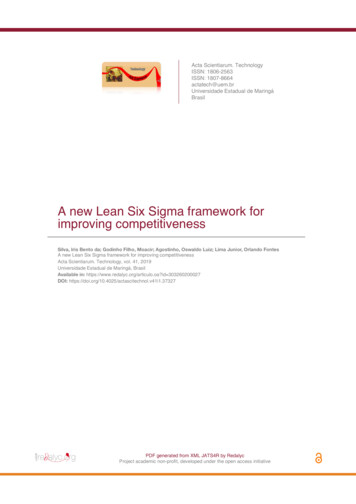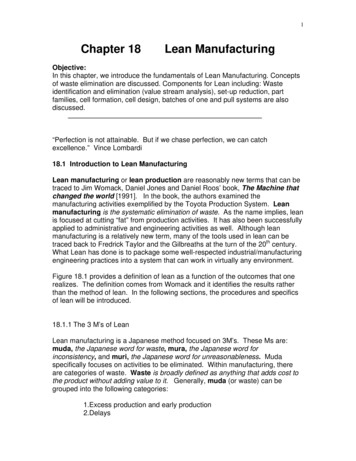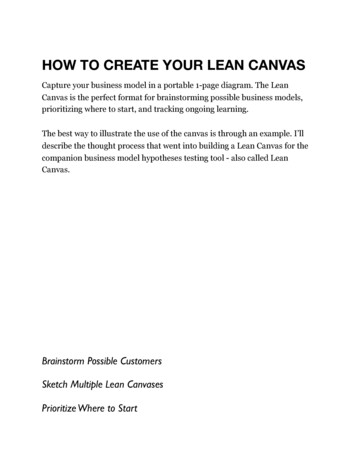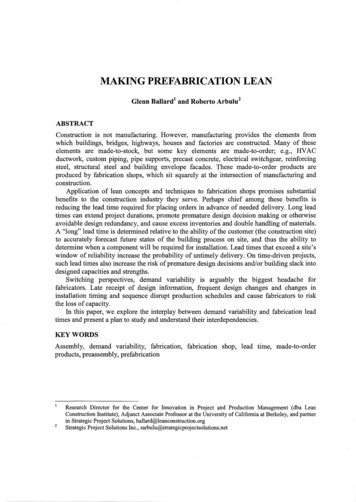
Transcription
MAKING PREFABRICATION LEANGlenn Ballard 1 and Roberto Arbulu 2ABSTRACTConstruction is not manufacturing. However, manufacturing provides the elements fromwhich buildings, bridges, highways, houses and factories are constructed. Many of theseelements are made-to-stock, but some key elements are made-to-order; e.g., HVACductwork, custom piping, pipe supports, precast concrete, electrical switchgear, reinforcingsteel, structural steel and building envelope facades. These made-to-order products areproduced by fabrication shops, which sit squarely at the intersection of manufacturing andconstruction.Application of lean concepts and techniques to fabrication shops promises substantialbenefits to the construction industry they serve. Perhaps chief among these benefits isreducing the lead time required for placing orders in advance of needed delivery. Long leadtimes can extend project durations, promote premature design decision making or otherwiseavoidable design redundancy, and cause excess inventories and double handling of materials.A "long" lead time is determined relative to the ability of the customer (the construction site)to accurately forecast future states of the building process on site, and thus the ability todetermine when a component will be required for installation. Lead times that exceed a site'swindow of reliability increase the probability of untimely delivery. On time-driven projects,such lead times also increase the risk of premature design decisions and/or building slack intodesigned capacities and strengths.Switching perspectives, demand variability is arguably the biggest headache forfabricators. Late receipt of design information, frequent design changes and changes ininstallation timing and sequence disrupt production schedules and cause fabricators to riskthe loss of capacity.In this paper, we explore the interplay between demand variability and fabrication leadtimes and present a plan to study and understand their interdependencies.KEYWORDSAssembly, demand variability, fabrication, fabrication shop, lead time, made-to-orderproducts, preassembly, prefabrication2Research Director for the Center for Innovation in Project and Production Management (dba LeanConstruction Institute), Adjunct Associate Professor at the University of California at Berkeley, and partnerin Strategic Project Solutions, ballard@leanconstruction.orgStrategic Project Solutions Inc., rarbulu@strategicprojectsolutions.net
INTRODUCTIONConstruction is not manufacturing. However, manufacturing provides the elements fromwhich buildings, bridges, highways, houses and factories are constructed. Many of theseelements are made-to-stock, but some key elements are made-to-order; e.g., HVACductwork, custom piping, pipe supports, precast concrete, electrical switchgear, reinforcingsteel, structural steel and building envelope facades. These made-to-order products areproduced by fabrication shops, which sit squarely at the intersection of manufacturing andconstruction.Application of lean concepts and techniques to fabrication shops promises substantialbenefits to the construction industry they serve. Perhaps chief among these benefits isreducing the lead time required for placing orders in advance of needed delivery. Long leadtimes can extend project durations, promote premature design decision making or otherwiseavoidable design redundancy, and cause excess inventories and double handling of materials.A "long" lead time is determined relative to the ability of the customer (the construction site)to accurately forecast future states of the building process on site, and thus the ability todetermine when a component will be required for installation. Lead times that exceed a site'swindow of reliability increase the probability of untimely delivery. On time-driven projects,such lead times also increase the risk of premature design decisions and/or building slack intodesigned capacities and strengths.Switching perspectives, demand variability is arguably the biggest headache forfabricators. Late receipt of design information, frequent design changes and changes ininstallation timing and sequence disrupt production schedules and cause fabricators to riskthe loss of capacity.The ability to measure, understand and manage variability is critical to effective projectmanagement (a paraphrase ofHopp and Spearman, 2000). Variability comes in many formsand types, of which demand variability is one, and can be understood for our purposes aschanges in requests after commitments have been made. 3 The specific application in whichwe are interested here is orders placed with fabricators that are subsequently changed eitheras regards the timing or sequence of deliveries or as regards the design of the product to befabricated. Such changes are disruptive to the fabrication and delivery process. Fabricatorsattempt to protect themselves from these disruptions through a variety of means, includinglonger lead times and double booking of capacity. 4 Unfortunately, these preventive measurestend to deteriorate total production system performance.Contracts are a contributor to the problem. Constructors rarely buy shop capacity, the useof shop resources, as opposed to buying products. Consequently the risk of capacity loss isborne by fabricators, who attempt to manage that risk by increasing lead times and double4Another type of demand variability is simply changes from forecasts or estimates."When the lead times exceed the site's window of reliability (which is most of the time) another result isthat the fabricators not only design prematurely but also fabricate to build up stocks from which they canthen supply just-in-time'. This is almost universal practice for US precast plants- they commonly produceup to 80% of a job before erection begins. The costs then include storage, cleaning, double-handling, andeven repair." (Rafael Sacks, personal communication to the authors, April 2004.) See also Sacks, et al.,2003.2
booking. Mass production thinking is frequently promoted by contractual terms of payment,which reward long production runs and early delivery. 5One key relationship between demand variability and lead time has previously beenidentified. According to Ballard et al. (2003), the lead time for acquiring specific products orservices is long or short relative to the requestor's window of reliability. If a contractor canaccurately predict one week in advance ( . has a one week window of reliability) when afabricated product will be installed, lead times greater than a week increase the risk that theproduct will be delivered earlier or later than needed. To further eliminate the waste involvedin idle inventories, double handling of materials, and workers waiting on work, the industrymust both increase work flow reliability and reduce supplier lead times, so that moreproducts and services can be pulled to the site when needed.This paper presents the framework and plan for research into the interdependenciesbetween demand variability and fabricator lead time. An initial section is devoted to thedefinition of terms, followed by sections on drivers of fabricator lead time and drivers ofdemand variability. A case study is then presented in summary form to ground the definitionsand concepts in reality, and is followed by a section stating conclusions and the plan forfuture research.DEFINITION OF TERMSThis section is devoted to explaining how we are using the following key terms: assemble,fabricate, make, manufacture, preassemble, produce, prefabricate, prefabrication (premake).Following the lean construction tradition (Ballard, et al., 2003), we understand"production" to encompass both designing and making. The focus of this paper and thisdiscussion of terminology is on 'making' and its associated and component terms, withmaking always understood in its connection to designing.In ordinary speech, "fabricate" suggests providing materials with desired properties suchas shape, density, tensile strength, etc. "Assemble" signifies joining together. Consequently,it is natural to understand fabrication as providing the elements which are to be assembledtogether (recognizing, of course, that there may be an indefinite number of subassemblylayers).MakeIFabricateAssembleFigure 1: Types of 'making'"Again, this is the case in practice in precast concrete. Most clients demand early production so that theycan confirm quality and supply before erection, and are willing to pay for it. The contracts usually include75-80% payment on production (and the rest after erection)." (Rafael Sacks, personal communication to theauthors, April2004). See also Sacks, et al., 2003.3
"Preassemble" and "prefabricate" place these activities before some reference point in time,which in construction is typically site installation. "Manufacturing" suggests factoryproduction, which is usually, though not always 6 , dedicated to making multiple copies of adesign already existing, and includes both fabrication and assembly. "Making" also coversboth fabrication and assembly, but is not restricted to factory production.We use the terms largely in their ordinary meanings: Fabricate: to provide materials with desired properties such as dimensions,density, tensile strength, conductivity, etc., by means of molding, cutting, heating,mixing, separating, etc. Assemble: to join materials together by bolting, welding, glueing, nailing, etc. 7 Make: to bring a material object into being by fabricating and/or assembling. Prefabricate: to fabricate all or part of an object in some place other than its finalposition. Preassemble: to assemble all or part of an object in some place other than its finalposition.Along with the above, a term is needed that encompasses prefabrication and preassembly.Given the previous definitions, the needed term would seem to be "premake" and itscompanion "premaking", but these terms are not in common use and no unique term existswith this meaning. "Premanufacturing" suggests factory production, which is too narrow,given that effective prefabrication and preassembly can occur on site; for example,preassembly of structural steel frames on the ground rather than in situ, or prefabrication ofconcrete in mobile hatchers. Gibbs' term "off site fabrication" does not work for that samereason (Gibbs, 1999). The best existing term seems to be "prefabrication", which is oftenused to indicate making something in advance of some temporal reference point. Oneexample is the expression "prefabricated piping", used to refer to the production of pipespools prior to final assembly on site. Piping 'prefabrication' is a combination of fabrication(cutting straight run pipe to length, shaping a trunnion to fit to the curvature of the pipe) andassembly of previously fabricated components (pipe, fittings, flanges, valves, in-lineinstruments). Obviously, there is potential for ambiguity given the distinction betweenfabrication and assembly, but the difficulty of getting a new term accepted persuades us torun that risk and so add "prefabrication" to our list as follows: 7Prefabrication (premaking): making all or part of an object in some place otherthan its final position8 For a counter instance, see Wortmann, et al., 1997.Note that 'assembly' is a mechanical concept, referring to the linking together of components structurallyrather than chemically.Note that in the case of all 'pre' terms, the 'place' can be either on site or off site.4
DRIVERS OF PREFABRICATION LEAD TIMEFabrication lead times are specified in the amount of time before initial delivery of product acustomer order must be placed; in other words, the amount of time between acceptance of anorder by the fabricator and the beginning of product deliveries to the customer.Fabrication lead times (FLT) are the sum of shop drawing production and review time(SDT) procurement time (PT) fabrication time (FT) preassembly time (AT) deliverytime (DT) allowance for changes (ACt Delivery, cycle, procurement and shop drawingtimes typically include a safety margin intended to accomodate variability around the averagedurations of each of these process steps. Backlogs of work orders can extend this lead time.FLT SDT PT FT AT DT AC 10Equation 1The first phase of the research will be devoted to quantifying these components. Ourhypothesis is that 'allowance for changes' is the largest component, or can be made thelargest component by applying lean techniques to reduction of fabrication cycle time. Somesupport for that hypothesis was found during a Lean Construction Institute visit to Trane'smodular air handling unit (AHU) factory in Lexington, Kentucky in 1998. Trane's factorymanagers explained that they had reduced the manufacturing cycle time for a modular AHUto 5 days, but still required 6 weeks order lead time because they expected, based on theirexperience, 3 changes to every order. We did not think at that time to inquire how thosechanges were divided between product design and process design (installation sequence ortiming).Production theory and the authors' experience suggest that fabrication lead times can bereduced in each of the above components by actions such as those shown in Table 1.Table 1: Opportunities for reducing fabrication lead timesLead time componentFabrication Lead TimeDelivery timeAssembly cycle timeFabrication cycle timeProcurement timeImprovement opportunityReduce the batch size of releases (transfer batch) to the fabricatorMake detailed engineering the first step in 'making'; i.e., pull fromInstallationA void breakdowns by preventive maintenance of equipmentDeliver to staging area in off-hours to avoid traffic congestion and assureavailability at target delivery timeDesign and manage tolerances to avoid the necessity of physical joining ofassemblies to assure fitReduce setup times and thence process batch sizesDesign for fabrication and assemblyStandardize parts; reduce part countReduce matching problem 1z by restructuring supply chains9Allowance for changes should be recognized as a separate category in order to avoid concealing allowancesin the other components.10With the addition of allowances for variability around averages:FLT DT DT, AT AT, FT FT, PT PT, SDT SDT, AC11The less time it takes to change from making one type of product to another, the less reason to increase thesize of production runs to reduce the changeover (aka, setup) time as a percentage of total time.5equation2
Shop drawing timeAllowance for changesIntegrate detailing into design production, thus eliminating separateproduction and review of shop drawings 13Reduce the risk of changes in product design by reducingfabrication lead timesReduce the risk of changes in product design by makingdesign decisions at the last responsible momentReduce the risk of changes in installation timing or sequence throughimplementation of the Last Planner system by the installerShift the risk of demand variability to the the party best able to control it;i.e., the installer. This can be done by having the installer purchase shopcapacity rather than products from the fabricatorDRIVERS OF DEMAND VARIABILITYBut, the reader may be thinking, is demand variability really so great? And even if it is, aren'tstores of completed products just the solution needed?Lacking quantitative data at this early point in the research, we must rely on thetestimony of industry practitioners, who report that changes in orders placed with fabricatorsare common and frequent. What are the drivers of these changes and what can be done toreduce the frequency and impact of changes? Those are questions to be answered moredefinitively in the future research, but we can perhaps usefully speculate here regarding thesematters.Work flow variability measurements from implementations of the Last Planner system ofproduction control commonly reveal percent plan complete figures ranging from 30% to70%, meaning that 70% to 30% of tasks committed to being completed in a plan period werenot completed (Ballard and Howell, 1998). The authors have also frequently observed designsquads and construction crews do work out of optimum sequence in an effort to avoid loss ofcapacity or in an effort to maintain scheduled progress-a practice known in the industry as'chasing work'. It has been noted by Kim and Ballard (2000) that the use of earned value as ameasure of progress invites working out of sequence (chasing work) because it does notattribute any value to the sequence in which work is completed.Consequently, one type of change in orders placed with fabricators is expected to concernthe timing and sequence of deliveries, and are hypothesized to be driven by changes in thetiming and sequence of site installation activities.Another type of change in orders placed with fabricators is expected to concern theproduct itself, and is hypothesized to be driven by design changes; i.e., changes in thegeometry or composition of the fabricated products. The authors also expect to find thatdesign changes themselves are driven in part by the time pressure on designers, which tendsto increase as installers demand ever earlier delivery of fabricated products. The1213The probability of on-time delivery of n parts to a station in a supply chain is the product of the probabilityof on-time delivery for each of the parts. For example, if there are three parts, with A's probability at 99%,B's at 95% and C's at 97%, the probability of on-time delivery of ABC .99 * .95 * .97 91%.See PCSC (2003) for an initiative led by Chuck Eastman at Georgia Tech to develop a bespoke 3Dmodeling program for a consortium of precast concrete fabricators in response to finding that engineering(shop drawing production) was the largest contributor to lead time (they did not isolate an Allowance forChanges).6
interdependence between these drivers is apparently quite complex. See Figure 2 for time ourattempt to display that interdependence.Starting at the top, we suppose that the contractor's production control practices arecharacterized by low PPC and chasing work. This drives changes in the installation rate orsequence, which drives changes in the required delivery date for fabricated products and alsoincreases the amount of fabricated products in the contractor's inventory buffer because someproducts will have to wait to be installed after they are delivered. If delivery dates arechanged, that will cause the fabricator to increase his lead time in an effort to protect himself.That increased lead time will cut into the time available for design, which will tend toincrease the probability of later design changes, which in tum will further drive changes ininstallation rate or sequence. Design changes will also have a greater negative impact, thegreater the amount of fabricated products already made. Fear of this consequence tends tocause contractors to order even earlier, which further increases the frequency of changes ininstallation rate or sequence and directly increases the amount of fabricated products in thecontractor's inventory buffer. This can also occur as a consequence of payment terms, whenfabricators are paid upon delivery.Supposing for the moment that the causal relationships illustrated in the diagram are real,we see that contractors tend to cause the opposite of what they intend. They chase work in anattempt to stay on schedule or accelerate, but the consequences are slower,Contractor's production controlpractices: low PPC, chasingworkl.ncreased '1; ;: ea ;; ;!, ----- ·: .-: ;;, "",:;, . "'itefdelivery offabricateditemsIncrease infabri cater'slead timeReduced timefor designIncrease incontractor'sinventorybufferJ \ Frequenc ochanges 1delivery teFigure 2: Interdependence of demand variability and fabrication lead7
more costly projects. It does not seem likely that contractors would deliberately reduce theamount of time available for design if they understood that doing so increases the frequencyof design changes. The problem is that the interdependencies are not understood; in partbecause they are complicated, involve multiple parties, and result from actions acrossmultiple projects. For example, frequent changes by contractors in fabrication orders causefabricators to increase their lead time, which in turn robs designers of time to do their jobproperly, which increases the frequency of changes in fabrication orders.Breaking out of this vicious cycle will require joint action by the major players, since noone party controls the entire system.CASE STUDY IN MODULE FABRICATIONIn December, 2003 the authors did a study, unpublished, of the off site fabrication andassembly of mechanical-electrical modules. The study was done just prior to the start offabrication. An example of the type of modules studied is shown in Figure 2. The materialand information flow diagram of the module production system is shown in Figure 3.The modules were designed and installed by a contractor responsible for engineering,procurement and installation, referred to here as the EPC Contractor. The Fabricator wasawarded a contract to do detailed engineering, to fabricate and to deliver modules to theinstallation site. Coordination of fabrication and installation was to be achieved by means ofa periodically updated schedule and by means of module releases. Modules were to bereleased by building zone and module type two months ahead of scheduled start of moduleinstallation. Each module was sized to what could be hauled by truck and trailer across publicroads without special permit. Modules were of different types, all mounting mechanical andelectrical equipment, wiring and piping on light steel frames, with the mounted itemsdesigned to be coupled together in final position.Figure 3: Mechanical-Electrical modules (Pasquire and Connolly, 2002)8
Engineering and detailing were expected to take 5 weeks. The EPC Contractor held contractswith the suppliers of all components and materials with the exception of the steel componentsused to build the module frame, the contract for which was held by the Fabricator. TheFabricator ordered made-to-stock components (from the steel component supplier directlyand otherwise through the EPC Contractor) weekly, and ordered made-to-order componentsby zone release, the first of which was to contain 13 modules. Lead times for materials andcomponents were not determined, but made-to-order products often take 2-6 weeks or more,which would add considerably to procurement time and would make matching more difficult,and hence increase the probability of longer fabrication durations. Lacking actual data, weassume 1 week Procurement Time for all materials and components.The Fabricator planned to fabricate all items in a zone release prior to starting moduleassembly. Fabrication was expected to take approximately 6 weeks, plus 1 week forgalvanizing the steel members, then two weeks for module assembly. All of these durationsappear to have included contingency, but that was not specified quantitatively. Moduleassembly was increased in duration by the need to physically build two modules together toassure fit, after which one was to be shipped and the other remain behind for the next fit.Consequently, two modules rather than one were in assembly at any point in time, increasingassembly duration from one week to two.Delivery was to be made in two stages: first to a staging area near the site, where the planwas to maintain 3 modules 'just in case', then another 2 modules on site, including themodule in process of being installed. Deliveries of specified modules to the staging area wereto be done only when requested by the EPC Contractor. Similarly, deliveries from stagingarea to Site were to be done only when requested by the EPC Contractor. The transit timefrom Fabricator to Site was one day, so Delivery Time amounted to 5 days 14 No explicitprovision was made either for variability around average durations or for Allowance forChanges, although the specified process durations very likely include such allowances.Substituting values in Equation 1 yields a value for Fabrication Lead Time of 16 weeks 15 :FLTMEPModules 5 weeks (SDT) 1 week (PT) 7 weeks (FT) 2 weeks (AT) 1 week(DT) O(AC) 16 weeks.Given this production system design, how will the system behave? From the causalrelationships shown in Figure 2 and he system design shown in Figure 4, we can predict witha very high level of confidence that the buffer of finished goods (completed modules) will fillall available storage space, increasing WIP and reducing flexibility to changes in sequenceand timing, with the consequences shown in Figure 2; namely, increased risk of designchanges (more completed modules to be impacted by design changes); increased cost forwarehousing, handling and maintenance; accelerated owner payments 16 as the Fabricator will141516These durations, inventories and rules were agreed during the course of the study. The original durationsand inventories were larger and rules for pulling modules forward were not explicit.If lead times for made-to-order components were greater than one week, the lead time would be increasedby that difference. For example, if the component with the longest lead time was 6 weeks, the total leadtime for the system would be 21 weeks, further increasing risk and vulnerability.Assuming that fabricators are paid on completion of a module.g
naturally want to be paid regardless if the modules can be installed; lower on-time deliveryrates and/or increased cost from the Fabricator starting and stopping work in attempting tokeep step with site changes. What could be done to avoid these problems?RECOMMENDATIONSThe following recommendations were rejected by the EPC Contractor, perhaps influenced bythe fact that the risks associated with the production system design were borne entirely by theclient and not by the contractor.10
Included in the Proceedings of the 2004 annual conference of the Interuational Group for Lean Construction. MEP Modules(IQE;(!):1:' (!):::!.!::.§0.s·8'8P ;::t.0 i:!l. 18'.; 1d a y - 3 d a y s - 1 day1 day-g0. weeks 21wee /-1week -------- 'dag.{");::t.0 a;."'sLegendESnMATED LEAD nMESEngineering Lead lime 5 weeksProdudlon Lead lime 9 weeks (7 2)Deliyery & Installatjon - 1 weekTotal Lead time 15 weeks -. .b Lead TimesFlow of MaterialsFlow of Information11"::.'11. ·: \'·:::::le
Explore means for reducing variability in site installation rate or sequence,including implementation of the Last Planner system of production control(Ballard & Howell, 1998). Reduce supplier lead times. Improve fabricator processes-Evaluate the alternative of purchasing fabricator capacity in order to removethe incentive to continue production despite an interruption in site installationEvaluate & recommend plan to use pull mechanisms to coordinate work flowbetween feeder stations and primary workstationsExplore, evaluate & develop means for assuring alignment of modules thatdoes not require physical 'batch' assembly.-Explore, evaluate & develop the pushing of some subassembly and kittingupstream in the supply chain to reduce the matching problem.Reduce batch sizes of manufacturing releases.-Evaluate in more detail the estimated durations for fabrication and assembly.Explore the possibility to fabricate the components and sub-assemblies forone module at a time, (allow batching in fabrication as long as it doesn'tinterfere with the pace of one piece flow). This could cut fabrication time inhalf. Improve Design/detail ProcessExpedite design completion to allow sufficient lead time for supply (beingmindful of the need to truly complete design).Explore, evaluate & develop means for reducing the probability of designchanges and for accommodating design changes.Evaluate practicality of completing detailed engineering as the first step in themanufacturing work stream. Improve Commercial ClarityDesign and implement a plan to measure the holistic value stream andcompare to current commercial model.Generate a risk/opportunity commercial model for implementing some/all ofthe above.12
CONCLUSION AND FUTURE RESEARCHAs illustrated in the case study, fabricator lead times tend to be inflated, in part in an attemptto protect the fabricator from demand variability. This inflation amounts to a type of buffer orcontingency insuring against the risk of demand variability. We suggest consolidating the'contingency' provided for demand variability in a separate category from the othercomponents of fabrication lead time so that it can be better managed. This is the strategyadvocated by Goldratt regarding schedule contingency (Goldratt, 1997).Reducing demand variability and fabricator lead times must occur together, and willrequire collaboration at minimum between installer and fabricator, and for more fundamentalimprovement, will require collaboration with architects and engineers as well. Owners mayplay a vital role in demanding performance improvement and requiring the application oflean concepts and techniques.Research is needed to support this critical industry initiative. Key research questionsinclude:1. Have competent users of the Last Planner system of production control reduced theirdemand variability? If so, have their fabricators reduced their lead times accordingly,or, if not, could fabricators safely reduce their lead times? Has increasing thecontractor's window of reliability enabled them to pull more products to installationdates? What can be done to further reduce work flow variability, and hence demandvariability?2. What are the lead times for various fabricated products; e.g., switchgear, HVACductwork, rebar preassemblies, precast concrete, pipe spools, pipe supports, cladding,air handling units, chillers, pumps? What can be done to reduce those lead timeswithout reducing demand variability? 173. What allowance for change should fabricators include in their lead times for a givenlevel of d
"Again, this is the case in practice in precast concrete. Most clients demand early production so that they can confirm quality and supply before erection, and are willing to pay for it. The contracts usually include 75-80% payment on production (and the rest after erection)." (Rafael

